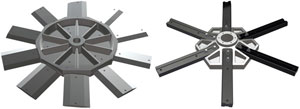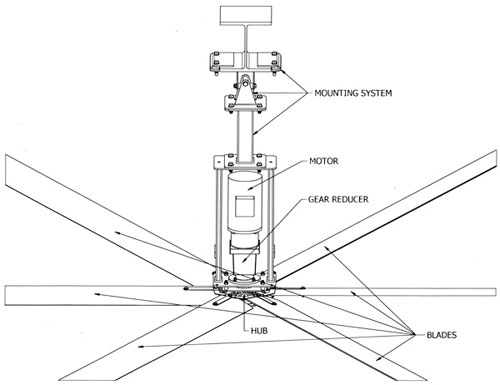HVAC for Large Spaces: The Sustainable Benefits of HVLS (High Volume/Low Speed) Fans
FAN CONSTRUCTION
 |
Typical 10-blade one-piece cast aluminum hub (left); New model 6-Blade Hybrid Hub (right) Image courtesy of MacroAir Technologies |
Motors. Typically, HVLS fans are powered by 1HP to 2 HP insulated motors. For ease of maintenance and replacement, design professionals should consider manufacturers who use only over-the-counter gearboxes and motors and non-custom frames, hubs, bushings, and safety systems. In addition, standard forward and reverse modes for use in both hot and cold weather helps maximize the customer's ROI.
Hubs. A typical HVLS fan hub is a one-piece cast aluminum unit with integral "winglets" to hold the blades. New designs are emerging, however. One company uses an innovative hybrid hub with a cast aluminum body and, in place of "winglets", bolt-on blade struts made from extruded aluminum to allow for easy installation and replacement of a damaged blade. Some hub designs allow the blades to be easily turned over in order to blow air upward, allowing the fan to be reversed more efficiently.
 |
Example of a free floating mount for an HVLS fan. This type of mount is vibration resistant, can be mounted at nearly any angle, and can be adapted for beams of various sizes and construction. Image courtesy of MacroAir Technologies |
Mounting system. Typical mounting systems for HVLS fans consist of several pieces. In general, these include a yoke that attaches to the beam in some fashion, a second yoke that bolts to the fan's motor frame, and a post or universal joint to attach the two together. It is important to be sure that any mounting system include safety cables and guy wires that are easy to install and strong enough to support the hanging weight of the fan. Some issues that often arise when placing HVLS fans into various kinds of structures include attaching the fan to either an angled beam, glued laminated timber construction, or an oversized beam. Mounting options for each of these should be available at little to no added cost. It is also important to specify a mounting system that does not transmit vibration to the building structure.
Reliability and durability. Always an indication of the reliability and durability of any product, length of warranty is a useful measure for design professionals. HVLS fan manufacturers offer warranties that vary from 3 to 12 years for service life. Some manufacturers also offer a lifetime warranty on items such as motor frames, hubs, bushings, and safety systems. When a fan is manufactured using standard motor and gearbox components, parts are easier (therefore cheaper) to replace and cost less if replacement is required after the warranty period expires. Design professionals should also ask about materials and methods used in constructing such parts as motor frames and mount components, as these can also vary from manufacturer to manufacturer. Finally, they should ask how extensively a manufacturer works with its suppliers to ensure that components are perfectly matched for each model.
Sizes and finishes. Standard fan sizes start at 8-ft and go to 24-ft in 2-ft increments. Most manufacturers offer custom colors and finishes for most components, including faux wood finishes and color anodizing.
 |
Components of a typical six-blade HVLS fan Image courtesy of MacroAir Technologies |









